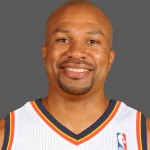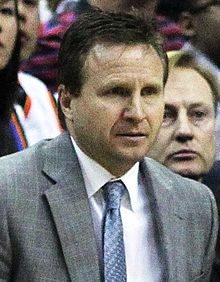Nevertheless, Ibaka still has a ways to go before he truly enters the realm of the elite. The main area that he will have to improve upon is his ability to create his own shot. He is too lightweight to back down most defenders and doesn’t have the handles to face up defenders. Thus, the key to developing his offensive independence is range. If Ibaka can  continue to hit the corner three with some consistency, it would go a long way toward opening the paint for the Thunder’s guards and possibly give him the green light to shake some defenders on the perimeter.
continue to hit the corner three with some consistency, it would go a long way toward opening the paint for the Thunder’s guards and possibly give him the green light to shake some defenders on the perimeter.
3. The consistency of Derek Fisher. Fisher has always been an enigma when it comes to his play with the Thunder. During the regular season, his minutes can look downright horrible. He will shoot in the 30s and have several games with oh-fers. His distributing ability is minimal at this point, and he acts as a defensive turnstile for quicker guards.
But in the playoffs, something changes, and Fisher suddenly becomes a crafty defender and a reliable spot-up shooter. I don’t know how to quantify clutch, but with what will be a predictably inconsistent young bench, Fisher needs to provide a steady rock that the Thunder can rely on.
4. The contribution of the no-offense trio. Perkins, Sefolosha and Nick Collison are among the least offensive-minded players in the NBA. As far as I can tell, none of them have a play drawn up for them in the playbook, and their ability to convert any offensive play – even basic ones – is extremely limited. All three are known quantities at this point, but it will be interesting to see if the Thunder can get any of them to contribute beyond their current levels.
Perkins was much more of a threat in Boston, where he played with better passers on the whole. Collison has shown flashes of a jump shot that could be useful at the right times. And Sefolosha can be useful on the fast breaks as well as in the corner.
I’m not expecting miracles, but when these guys can exploit a defensive mismatch or just get a bit lucky, it pays huge dividends on the whole. Think about it this way: The Thunder were 28-4 last season when one of these guys chipped in 10 points or more.
5. The rotation of Scott Brooks. In previous seasons, it was pretty easy to predict which spot would go to who. The Thunder always gave around 10-15 minutes to a backup point guard, 30 minutes to a reliable swingman scorer,  25 minutes to a backup big and extra minutes to a supplemental shooter or big. The only real exception was Derek Fisher, who got extended minutes in the playoffs.
25 minutes to a backup big and extra minutes to a supplemental shooter or big. The only real exception was Derek Fisher, who got extended minutes in the playoffs.
But this season, there’s no clear player to step into the main scoring role. The two biggest candidates are Jackson and Lamb, but both have potential drawbacks. Jackson is undersized at shooting guard and can’t take threes, while Lamb is too inexperienced to shoulder the majority of the load. Roberson, Perry Jones and even Ryan Gomes are all potential rotation players, if not clear candidates to take on a large offensive role.
My best guess is that Brooks finally diverges from the tried and true formula. He won’t morph into a Rick Carlisle by any means, and he will probably still have a very strict rotation. But the roles that you’ve seen the Thunder bench employ for the past four years will likely change dramatically.
Zebulun Benbrook is the manager of Welcome to Loud City, an SB Nation blog covering the Oklahoma City Thunder. He has written about the Thunder since their arrival and is a longtime NBA fan from Oklahoma City. You can follow him on Twitter @WTLC.